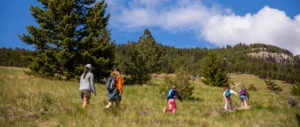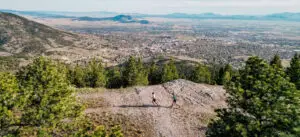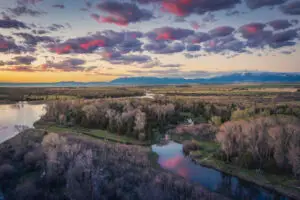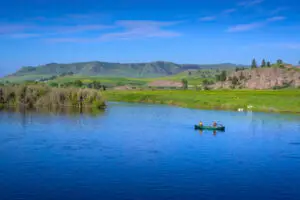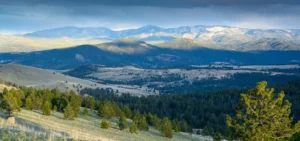One of my favorite ways to entertain family members from out of state is to take them to see pronghorn. We don’t have to travel far. Though not abundant, herds of these prairie grazers live in several parts of the greater Helena area throughout the year. It’s a treat to show visitors a truly all-American wildlife species that is also a symbol of the West and indicates healthy grassland ecosystems.
Pronghorn live here because the area still retains enough open space to allow for what biologists call “connectivity”—the degree to which wildlife can move freely across the landscape. “The fact that you still have pronghorn means you still have a functioning and resilient ecosystem that is allowing for essential processes, which include migrations and seasonal movements,” says Dr. Andrew Jakes, a senior research scientist with the Wyoming Migration Initiative who works from an office at the University of Montana in Missoula.
Pronghorn are endemic to North America, residing in the short- and mixed-grass prairies of the Great Plains from southern Alberta south to northern Mexico. Though commonly called “antelope” because it resembles Old World species, the pronghorn is not related to the antelopes of Africa and Asia. Nor is it kin to any type of goat, despite being dubbed “speed goat” in some parts of its range. In fact, its closest living relative is, of all things, the giraffe.
Both males and females have horns, which, unlike those on bighorn sheep or mountain goats, are shed each year. The male’s horns are longer than the female’s and sport a pronounced forward-facing prong from which the species gets its name.
“It possesses so many anatomical peculiarities,” wrote William Temple Hornaday, director of the New York Zoological Society in 1904, that “it is like an island in a vast sea . . . an animal more wonderful than the rarest orchid that ever bloomed.”
Though smaller than white-tailed or mule deer, pronghorn are easy to spot. Herds stand out in open prairie, rangeland, or harvested alfalfa fields, far from brush or trees where they could be attacked by coyotes, their primary predator. Their contrasting white and reddish tan coats can be visible from a mile or more away.
Pronghorns rely on extraordinary eyesight and blinding speed for protection. The animal’s big, bulging eyes magnify distant objects eight times greater than a human’s and take in about 300 degrees of its surroundings. When spooked, pronghorns take off running, often for a mile or more without stopping.
And their speed! According to Dr. Kerry Foresman, professor emeritus of wildlife biology at the University of Montana, pronghorns can reach 45 mph and sustain speeds of 30 to 40 mph for several miles. On the entire planet, only the African cheetah is faster on land.
Pronghorn numbered 30 to 40 million animals before westward expansion. Populations were decimated by pioneers and market hunters. Farmers plowing and burning the animals’ sagebrush habitat made for poorer living conditions for pronghorn. By the early 1900s, pronghorn numbers continentwide dwindled to an estimated 13,000 animals, most of them in Wyoming. Regulated hunting seasons and limits, along with trap-and-transfer programs, have allowed populations to increase to about 750,000 today. Wyoming still contains by far the most pronghorn in the United States (320,000 in 2024), followed by Montana (120,000) and Colorado (73,000).
The biggest threat facing pronghorn today is the conversion of habitat from open space and agriculture to subdivisions and industrial sites. Fencing on ranches, along highways, and within housing developments can also pose a challenge. Pronghorn can jump barbed wire fences, but they do so reluctantly. The animals evolved on open plains where jumping was not necessary. When blocked by a fence, pronghorn usually try to crawl under the lowest strand. That’s not possible when snow is more than a foot deep or with woven wire “sheep fences,” which extend to the ground.
In one north-central Montana study, Andrew Jakes found that some pronghorn migrating in winter spent hours trying to get past a single fence. “Imagine how much energy those animals expend in freezing conditions trying to negotiate hundreds of fences during their migration,” he says. Depending on how and where they are built, fences can make it difficult or impossible for the wide-ranging species to travel from wintering habitat to summer grounds where females raise their fawns.
Prickly Pear Land Trust is currently converting fences on a handful of properties to a standard that allows for pronghorn and wildlife passage. A complete fencing overhaul can be expensive, so PPLT provides financial incentives to private landowners in migration corridors to gradually convert woven wire with horizontal strand fencing. “That’s by far the most beneficial thing that can be done to facilitate pronghorn movement,” says Justin Gude, head of the Montana Fish, Wildlife & Parks research unit. The greatest role Prickly Pear Land Trust can play in pronghorn conservation is accepting donated and purchased conservation easements that protect land for critical migrations and seasonal movement. Travis Vincent, PPLT lands director, says recent large easements in Broadwater, Lewis and Clark, and Meagher counties are now conserving sufficient acreage to make a positive difference for pronghorn and other species. “PPLT has always done a good job of getting folks out on the trails and in parks,” he says. “But with these big projects, we are excited to show that we can have both happy trails and contribute in a big way to landscape-scale wildlife connectivity.”
Tom Dickson is a longtime editor and writer based in Helena, Montana, known for his extensive work in outdoor and conservation journalism. He recently retired after 23 years as editor of “Montana Outdoors,” the magazine of Montana Fish, Wildlife & Parks.


